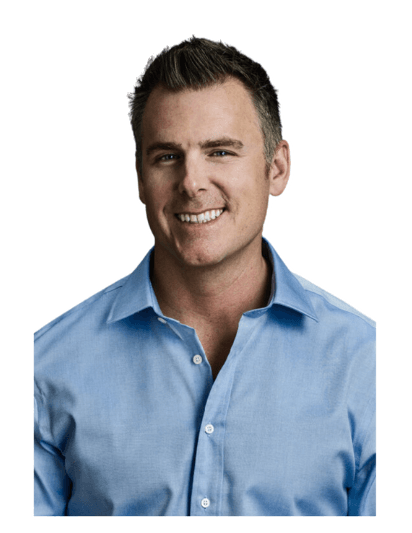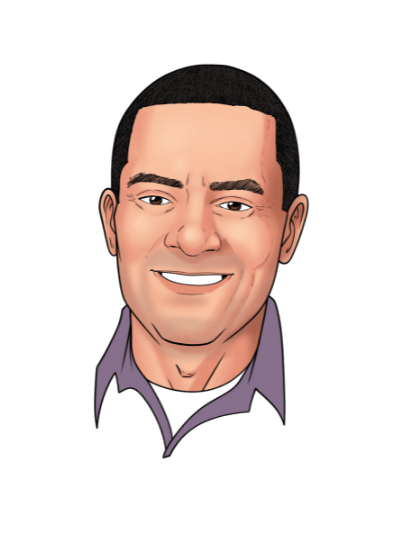
140
Episode 140 42 mins
How Do You Think About Time? The Psychology of Value per Hour and Getting More Done
Nick Sonnenberg, Founder of Leverage
00:00
00:00

Optimize for retrieval, instead of transfer. Your brain is for having ideas, not holding ideas. Align your team on when to use tools is more important than how to use them. Do one thing at a time, celebrate small wins, and get one thing working before you start. Don't try to roll out 10 tools all at once.
In this episode
Leadership needs to buy into changes in the company for them to work effectively.
Changes don’t stick when leadership has the philosophy of ‘do as I say, not as I do’.
Nick Sonnenberg is the CEO of Leverage, a fully remote business efficiency consulting company. He’s also a columnist for Inc. Magazine, and recent author of a Wall Street Journal best selling book.
Nick’s recently released book “Come Up for Air,” provides a framework for companies to use systems and tools to improve productivity and avoid drowning in work.
In episode #140, Nick emphasizes that time is not equal, and every hour on the calendar may not have the same value. Instead, each time slot has its own unique value.
We also dive into behaviour change in an organization, optimizing for a team, and hiring as a last resort.
Tune in to hear all about Nick’s leadership journey and the lessons learned along the way!
Like this episode? Be sure to leave a ⭐️⭐️⭐️⭐️⭐️ review and share the podcast with your colleagues.
04:03
Come Up For Air
12:46
ROI of increased productivity
18:43
Change management tips
22:34
Optimizing for document speed of retrieval
31:15
Why hiring should be a last resort
33:46
Not all time is created equal
40:45
Nick’s final words of wisdom
Resources
- Read Nick’s book Come Up For Air
- Follow Nick on Twitter
- Connect on LinkedIn
- Read Nick’s Inc. articles
- Read Deep Work by Cal Newport
Transcript
Aydin Mirzaee (Fellow.app) 04:03
Nick, welcome to the show.
Nick Sonnenberg (Leverage) 04:04
Thanks for having me. Yeah,
Aydin Mirzaee (Fellow.app) 04:05
I’m very excited to do this. I know you and I met quite a few years ago, and I’m very excited to actually have you on and Today’s a very special day for people who know you. They probably seen you because you are a columnist for all sorts of publications like Ink Magazine, and you’re the founder and CEO of leverage, which is an efficiency consultation, which again, this is like the stuff everybody talks about these days. And today, we’re very excited to have you because you are now the proud author of a best selling Wall Street Journal book called come up for air. So why don’t we start there? Why don’t we start with what is this book and why did you write it? The book came
Nick Sonnenberg (Leverage) 04:50
out just a few weeks ago and I hit number three on Wall Street Journal so super excited about that. It’s called come up for air because I know firsthand what it’s like to be drowned. I’m going to work. And the number one thing when I talk to people, clients, potential clients, and I say how are things going, everyone says they’re drowning in work. So I thought it was appropriate to title the book come up for air. The subtitle is how your team can leverage systems and tools to stop drowning in work. The reason why I wrote this book, there’s a couple of reasons. One, the goal of the book is to serve as the employee manual that you never got, in the sense when you get hired at a company, you get some handbook about health insurance, vacation days, core values, maybe the org chart, but you don’t ever get handed over kind of a book that says, hey, at this company, this is how we operate in terms of this is how we collaborate, we use Slack, we use Asana, we use all these tools. This is how and when we use it. And you really need to read this because it’s like speaking any language. And if you don’t read this, it’s like, I’m hiring you and you speak Chinese and I speak French, it’s just going to be hard to get work done. So it’s really not a book for individual productivity. But it’s a book for how a team or an organization can be productive. The content of the book is laid out, according to my CPR framework, which stands for communicate, plan and resource. Those are the three buckets that we found. Every company doesn’t matter if you’re a startup, or you’re in the Fortune 10. You need to communicate with people internally and externally. You have plans, you have tasks, you have projects, work needs to get done. And then you have your resources. You’ve got intellectual property knowledge processes. And so that’s the framework that I developed. And I developed it in case this is interesting for your audience, just to give a bit of backstory. Originally, leverage was a freelancer marketplace. It wasn’t an operational efficiency training consulting company. But we grew very quickly, we grew to seven figures in the first year 150, team members fully remote, and we did it because we were leveraging systems and tools and smart ways. And we tapped into a really good funnel for gaining clients. But we grew too quickly, frankly. And although we had that success, which impresses people under the hood, we had some issues, we were three quarters of a million dollars in debt, losing about half a million dollars a year bootstrapped that’s pretty painful. And our org chart was pretty broken. It was I was non people facing and my business partner was people facing so you can imagine. That’s not the most robust org chart for 150 person team. And one day, we were working together having coffee and he tapped me on the shoulder. He says that he’s leaving non two weeks, not in two days, he’s leaving in two minutes. And I’m thinking to myself, holy crap, like this is not going to be good. And I had to make a decision, do I bankrupt the company? Or do I try to clean things up that were happening under the hood. And in the coming three months, it was very tough, we lost 40% of revenue. And before I know it, I’m cashing out my 401k My dad is taking a second mortgage on his house to help us make payroll. And it was rough. I was drowning in work, I was working 1618 hour days. But I had a very clear plan of how to turn things around. I started realizing this CPR framework that I’ve started realizing that we were communicating really and efficiently, both clients and with team, it wasn’t easy to just answer a question like who’s working on what or what, what’s the status of a project, we were pretty good at documenting knowledge, otherwise, we probably wouldn’t have been able to sustain. And what I found is it was a tough three months. But after that very quickly, things started improving. And simultaneously, people started reaching out asking me to consult them on their businesses and how they could be more efficient. Tony Robbins started reaching out, others started reaching out. And the same stuff that was turning leverage around was just as helpful for Tony PooPourri. A seven figure, financial advisor didn’t matter the industry or size, everyone had very similar issues. Everyone has email, everyone needs to learn how to use email properly, everyone runs meetings, right. So that’s why tools like yours are so important to run efficient meetings. So there’s common things that regardless of if you’re a small company, big company, industry, there’s fundamental needs that you have to be efficient. And I started realizing the impact and importance we were making. So eventually I pivoted leverage from being the Freelancer marketplace, we were to being this world class operational efficiency training and consulting company. And my book is about this framework that I developed and our intellectual property that we’ve developed over the years on how to have a high performing efficient organization.
Aydin Mirzaee (Fellow.app) 09:17
Yeah, what a great story. And what a nice dad you have, though, is very nice of him to help you get to payroll that way. So that’s really interesting. So this was a marketplace and then you get to this situation, and you’re looking for these efficiencies, and you create this CPR framework. So what does it look like? So for an organization, I think, like everybody’s gonna agree, we’re drowning in work. We have all the problems that you mentioned. And where do people begin, like, how do you start to consult with these folks?
Nick Sonnenberg (Leverage) 09:47
It matters where they’re at, you know, if they have a lot of complexity, we developed a product just out of what we were seeing people needed called a roadmap where we do a diagnostic and we interview a series of people one on one and group. Because look, every company including and guarantee both of ours, there’s hundreds of opportunities that you can’t be too efficient, there’s always a better way of doing stuff. So we interview and we pull out kind of where the biggest opportunities are. And it’s not so much, you know, here are a list of all the things that are suboptimal. But this is the order in which you should fix things, because the order really matters. Not everything, you’re gonna get the same, I call it R O T, return on time, similar to return on investment, it might be really important to document some process. But if it takes you a really long time, and it’s not going to save you that much time, maybe that’s not the starting point versus, in general, teaching people how to use email better, that might just be a few hours of your time to learn. And now you might be saving three to five hours a week for the rest of your life. So different things have different priorities. So we always try to prioritize, and start with the thing that’s gonna have the highest ROI. And if we can quickly save you three, five hours a week and give you that breathing room. Once you get that breathing room, you’re no longer drowning in work, then we could, okay, let’s roll the next thing. Maybe it’s fellow, maybe it’s a sauna, maybe it’s whatever. And just one by one, it’s important to do things logically and do it well, because any tool, in my opinion, you only get value, if you have alignment from the team and people know when and how to use these things properly. If you don’t truly adopt these tools, it’s just another tool to maintain. So it’s important that you be strategic with the order that you do it. And one of the most common things, though, is a sent to you before we started recording, email, and meetings are the two most inefficient things that we see in company. So if you can clean those two things up alone, you’re well on your way. So we’ve developed group trainings, for example, on how to get to inbox zero. So you don’t need to necessarily do a massive roadmap with us. If you just want to learn how to deal with email better and save a few hours a week, people can join some of those trainings. And then we do private custom consulting where, you know, you might have a complex workflow, and we come in and help you optimize, automate it, document it.
Aydin Mirzaee (Fellow.app) 12:04
Yeah. Again, like these days, efficiency is what everybody’s talking about. And it takes various forms, you know, there’s companies out there that are saying, Hey, we’re gonna try and go to a four day workweek, and you know, cut an entire day out, or, you know, companies just looking to say, hey, we’re not going to be able to hire as much this year, and we’re looking to get more out of our teams. And so there’s two ends of the spectrum, but all of it subtly is hinting at, yes, we need to get more efficient. So just so I get a sense, you know, a lot of the things that we talked about on this podcast are like very people related. And what I really like about the work that you do is it’s people process and tools mixed into one should that people get a sense, like, what do you think the ROI is? Like, if you teach a whole company, let’s just make up a number, you know, 100 person company to really check email in the right way? What does that do to a company? Like, what is the ROI? To think about there?
Nick Sonnenberg (Leverage) 13:00
Let’s just do the math. Right? What do you want to assume the average salary isn’t that 100? person company? $100,000 a year? Like just easy math? easy math? Yeah. Right. So let’s say your payroll is 10 million a year, right? If you’re working a 40 hour workweek, and you say four hours a week by learning email a little bit better, which is very doable. That’s a 10%. Productivity lift right there. So on a 10 million payroll, that’s a million dollars in bottom line productivity back, you can apply the same thinking to, you know, what’s the impact of learning how to run more efficient meetings? Like how many? What percentage of time are you wasting on inefficient meetings? What percentage of time are you wasting, not having a good work management tool and going on a scavenger hunt, trying to chase people on status of projects or tasks? So the easiest way to think about the impact is always I always just go back to what’s your payroll? How many hours a week do you estimate you’ll save what percentage of payroll is at times the two together, and so $10 million, your payroll, you easily could save a million dollars, and you’re not going to see that in cash, you’ll see that in more productivity that that extra four hours now those people can reinvest into higher level more impactful work that can make an impact, but I view it as a million dollar a year value creation.
Aydin Mirzaee (Fellow.app) 14:16
Yeah. Or you can say like, we wanted to add more people to the company this year. But now maybe we don’t need to do that. Because our team is just capable of doing, you know, a lot more. I mean, that’s interesting. So how does one come up with an assumption on how much time you can save on email? I kind of feel like with a lot of things with driving, everybody thinks they’re above average drivers. And so I wonder with email, you know, I don’t know that a lot of like, they’ll say, I’m drowning in email, maybe. But do they think that like, there’s that like, how much leverage is there? Like, you
Nick Sonnenberg (Leverage) 14:49
got two buckets? You got one where people just say they admit I’m drowning in email. I need help help me. And then you have another category people where they think they have a good system, and then they’ve got all these complex folders. and marking things read and unread. And what I can guarantee everyone listening is. Email is one of most misused tools. It’s tricky because people have developed bad habits over the decades tools like fellow tools like Asana, Slack, they haven’t been around for decades, they’re relatively new email people have been using for a while. So you have to unwind certain behaviors. But our framework, we have a framework called ra D, reply, archive, defer, you don’t need as many folders as you’re using. Most people aren’t utilizing snoozing that’s built into these things. They’re not utilizing search, they’re not using some of the advanced settings. So very, very quickly. Also, mindset wise, all email is is an external to do list that other people can add to. So marking, read or unread isn’t the right way of thinking about it. If it’s not something you need to deal with, it should be moved to your archive, or snoozed. I talked about this in my book. So you got the two buckets of people, people that are desperate for help and people that are a little bit stubborn, ultimately, once we show them the better way, and we kind of survey people pre and post, how many hours a week are you spending on email now versus after we’re seeing on average, three to five hours a week reduction in time spent an email? So that’s where I’m getting those numbers from?
Aydin Mirzaee (Fellow.app) 16:11
Yeah, my personal pet peeve on email, and I will move on from email in just a sec is the one SEER if you’re a CEO of a company, and every vendor under the sun can guess your email address and send you these cold emails? Is there a solution to get less cold emails? This is one of my pet peeves.
Nick Sonnenberg (Leverage) 16:32
Well, I mean, if it’s coming from an individual, that’s manually writing to you, that’s probably tricky. You just got a I mean, maybe you can figure out what list are pulling it from. But in things like Gmail, for example, you can use like promotions, social update tabs, so you get the algorithms of Gmail to automatically filter things to what they deem is less important. And Outlook, you have focused and you have the focused inbox that you can enable. So hopefully picks it up there. Any email that has the word, unsubscribe, opt out, most likely, is not going to be a super urgent email. And those platforms should automatically filter it to one of the lower priority tabs.
Aydin Mirzaee (Fellow.app) 17:12
You know, at some point, I should share with you my list of filters, I think I have like 120 or so filters around. I use Gmail, but to solve this problem. So it’s not just the word unsubscribe, I also have things like we help companies alike, and all the different phrases that people could that could signify that this might be a cold email. So I’ve done a lot of work there, but they still get through. So
Nick Sonnenberg (Leverage) 17:39
well. Do you have you enabled the forums, updates, promotions and social tabs? Yes, I have those too. And are your filters doing anything different than what the algorithms of Google are already filtering?
Aydin Mirzaee (Fellow.app) 17:53
Yeah, I think my filters definitely also take out a lot more.
Nick Sonnenberg (Leverage) 17:57
And when where’s it putting it? Your filters? Just auto archive it? Yeah, auto archive. Gotcha. So you just never see anything that says the word we help businesses like you’re just never see,
Aydin Mirzaee (Fellow.app) 18:07
never see. Yeah. And I was thinking of making something like this public. But then I thought that’s a bad idea. Go on a, you know, help more of these emails get through. But all this to say is like, this is a very deep area. And you know, as you’re talking, I’m like, yes, these are things, these are inefficiencies. And sometimes the lazy answer to some of these things is let’s hire more people. But you know, once you start looking at the processes and breaking it down and thinking about the tools, like there are ways to get more out of your current team and the ROI, I mean, like you demonstrate, it’s totally worth it. Let’s talk about something else, though. So I think one of the challenges, of course, is you bring new people into the company into the organization, and people from external companies, you hire them in, they have their own habits, their own ways of doing things. And I think like, this is one of the things that makes it really hard to instill behavior change within an organization. So we’d love to hear your thoughts around. Okay, you went in, you taught a company a bunch of things on how to operate better using a tool or process, like how do you make sure that that change sticks over time, the behavior
Nick Sonnenberg (Leverage) 19:15
change is the hardest part with these things. Depending on the tech savviness of the company, ultimately, you need leadership to be bought into this. And to really have any serious change. HR should be including this in the annual mandatory training. Training is just as important as sexual harassment. This should be part of the onboarding. So instead of just onboarding people and teaching them about your core values, you should onboard them and teach them best practices of the core tools required to be successful at that company. So you know, it really starts at the beginning of the journey, things specifically that leverage does to help support clients is we have different offerings where you have access to our learning management system of courses, and then we also have kind of a private community where people can ask for questions and ask for help throughout the year. And so we’re kind of like this. And it’s not really like outsourced it. But we’re kind of like a really, we’re like a ninja customer support for all the tools. But we’re not just customer support of a tool we’re looking more holistically to help people be more efficient and learn the purpose of these things. So we offer a lot of ways to help support but you really, regardless, if you work with a company like leverage, or just try to do this yourself, it needs to be bought in from the top, this stuff doesn’t work where leadership has the philosophy do as I say, not as I do, and I don’t need to use these tools, you just need to and if you want to talk to me, you have to text me and someone else wants you to email them and someone else wants you to Slack them. It’s worked hard enough, you can’t keep track of everyone’s personal preferences. So it’s really important to make sure that there’s alignment and buy in, because otherwise, it’s just not gonna stick and it’s just gonna be a waste of everyone’s time.
Aydin Mirzaee (Fellow.app) 20:57
This is exactly like me, I think for sure the leaders need to be bought in on these sorts of changes. And then they also need to use those same tools. And it gets built into the workflow and knowledge management of the company. And I think this is one of those things and when it’s not done, and if your company is big enough, you start to notice that different systems pop up in different places in your company. And then you realize that this is a I mean, these things can kill companies, right at a larger scale, these things can be real bottlenecks. Hey, before we move on to the rest of the episode, if you’re an engineering leader, whether manager, director, or VP, all engineering leaders know that one on one meetings are a powerful tool for team engagement and productivity. However, not all leaders know how to run these meetings effectively. That’s why the fellow team just released a comprehensive guide on the art of the one on one meeting for engineers. It has over 60 pages of advice from engineering leaders at organizations like Apple, MailChimp, Stripe, GitHub, Intel, and more. We’ve also included expert approved templates for you to apply immediately to make your one on one meetings that much more effective. So head on over to fellow dot app slash Resources to access the guide and the exclusive templates right now. We’ll also link it in the show notes for you to check out there. But you can go on over to Fellow.app slash resources to get the guide and the templates today. And with that said, let’s go back to the interview. One of the quotes that we have from you is that you recommend teams shift their mindset to optimize speed of retrieval, over speed of transfer of information. Maybe you can explain that and give us an example of how that might transpire.
Nick Sonnenberg (Leverage) 22:48
Yeah, that’s kind of like the underpinning philosophy with all of these things. What I realized is, when you’re thinking about it, when you’re busy, you’re drowning in work, you’re working 1214 16 hours a day, you’re just desperate, you’re just trying to cut whatever corner you can, and then you’ll text someone, you’ll email someone, you’re just trying to get it off your plate to move on to the next thing because you’re literally drowning in work. And so this game of hot potato is in math, because I come from a math background, we call it a local optimization, it’s just for yourself in the moment you did what was easiest, what was best. But tomorrow, or next month, when your colleague needs to find that piece of information, you know, and they got to look in 10 different places, and they’re wasting 30 minutes, an hour, or maybe they never even find what they needed to look for. You need to avoid all those. So the idea of not optimizing for the individual but doing a global optimization, how can you optimize for the team? And when you shift to that mindset, you start thinking about strategies not to just get stuff off your plate, but how do you put things in the right drawer so that it’s easy to find. And I’ll give you an example in your personal life. When you do your laundry, you don’t just take stuff out of the dryer and thrown into one drawer, you separate your socks from one drawer, your underwear in another drawer. You don’t do that. Because it’s the fastest way to be done with laundry the fastest ways you just throw it all in one drawer, you invest the time to separate things out. Because tomorrow when you need to put an outfit together, it’s much easier to retrieve what you’re looking for. And so people need to be thinking about how can I invest? We’re not talking crazy investments. But sometimes it’s the difference of investing five seconds, 10 seconds to slow down and put something in the right drawer so that your colleague can easily find it next week. And when everyone’s thinking like that, then what goes around comes around because next week or next month, when you’re looking for something, you can trust that it’s in the right drawer and it’s in you’re not going to have to waste minutes or hours looking for it. And so that’s really the secret to everything we’re talking about. My CPR framework is just a framework and a guideline into the different drawers that you need in your team so that it’s easy to retrieve whatever you’re looking to retrieve.
Aydin Mirzaee (Fellow.app) 24:53
Yeah, this is super important. So and I love the the laundry example that really helps explain it. What’s the example of this, I have a feeling that you’re not going to like my habit of maybe sometimes sending voice memos, which is ultra convenient and short term optimized for me, but may not be as much if such Voice Memo is sent in a group chat, for example, with a bunch of people, what are some examples of like things that people do that they shouldn’t do and do it a different way, like very practically with tools?
Nick Sonnenberg (Leverage) 25:24
Look, I’m not anti group, like I did one. Today, I was walking on the treadmill this morning, I use an app called loom. I recorded a two minute audio of giving feedback. And I posted that in Slack to a group chat in Slack. But I didn’t text it to them. I didn’t email to them, you know, I had to communicate something to them. And slack is our internal communication tool. I think it also depends. Do you need to hold someone accountable to this? Is this something that you’re gonna need to reference and possibly find in the future? If it’s just the equivalent of meeting you talking in person, and we’re not taking notes, we’re just chatting, you know, it’s fine to send an audio, you just have to really be thinking about, you know, in a month, do I need to find this? If so, you know, my am i doing things in a way that’s going to make it easy to find in the future? If you email someone and say, Hey, can you write this report by Friday? That’s bad. Because according to my CPR framework, email is a communication tool, right? If you want to hold someone, if you’re delegating tasks, or projects to people, that should be in a project management or work management tool, there’s functionality in those tools built for purpose, right? You want to be able to click a button and hold someone and know everything that Nick is working on everything that’s past do, what’s the status of that report that you ask them to work on? Emails, or communication tools for communicating can’t click a button and answer some of those basic questions. It’s a great tool for certain purposes. So a lot of people are using email, for example, in lieu of using a tool like Asana, for example, or a Monday for work management. A lot of people are using email to communicate, but they’re communicating with their team. So they might ask a colleague, like, Hey, do we have Friday off? Well, that’s not something you need to hold someone accountable to. That’s just communication. But in my book, we talk about separating internal communication from external. So if you’re talking with a colleague, you probably want to be using a tool like Slack or Microsoft teams to hold those conversations. Those tools are built for purpose, there’s things, there’s functionality, those tools have that optimize it for internal communication, if you think about email, the logic of how it’s ordered is chronological. If you look at a tool like Slack, or Microsoft Teams, it’s ordered by topic, and you can create these channels. And so these tools have functionality to make it easier for certain use cases. And so even if you don’t use all the functionality of these tools, just separating and knowing, hey, I go to this tool for this purpose, you’ve already eliminated the scavenger hunt by an order of magnitude because you know where to look for something, right. And let’s just take fellow, for example, I’m sure that there’s functionality I’m not yet aware of, because we’re just getting really ramped up on it. But even just knowing Hey, for an agenda, that’s where we look, right, you don’t have to stress if you’re using all the automation, all the functionality, just knowing Hey, for an agenda we use fellow and knowing for the most part, like some of the basics, you already get a lot of value. And you know, you don’t have to look in a Google Doc and an Asana project in the calendar, which is happening right now with a lot of teams listening, where you get these fragmented agendas, like just knowing this tool we use in this case, already is a massive productivity left for teams.
Aydin Mirzaee (Fellow.app) 28:31
Yeah, this is a very good point. And I have seen this is like really great, best practice at some very large companies where they very specifically, I mean, they don’t have to be that large, this good press practice for everyone. But just identifying the way you said. And the other thing that came to my mind, you know, from an efficiency perspective is again, people bring different habits. So some people really do use email as a to do list, right? And so we talked about why they shouldn’t. But the problem is, if you’re different people in your company manage things in different ways and have a different idea of what each tool does. This is how things get lost and you lose efficiency, because oh, I sent you the task you’re supposed to do on Slack. And oh, I didn’t see it. Where was it? Oh, is in a thread? Oh, we lost a week of time because it wasn’t put in the right drawer.
Nick Sonnenberg (Leverage) 29:20
Totally. Often people are like, what’s the best tool for this? Is it Monday? Or is it Asana? Is it slack or Microsoft team? They’re all very good tools. It’s a personal preference. For the most part. The most important thing is you have alignment with your team that they know where to look for stuff. So you don’t have that scavenger hunt. That’s the most important.
Aydin Mirzaee (Fellow.app) 29:38
Yeah, this is just like an interesting thing. I mean, so then would you agree that if you’re on Slack, and you’re messaging and you’re asking someone to do something, please give me this TPS report? Is that a place to do it? Or do you go to a work management system to do something like that?
Nick Sonnenberg (Leverage) 29:54
I’ll give you an analogy. Imagine you were to do a team off site. And right now we’re going through about other economies. So imagine you’re not going into the four seasons, but you’re doing like a camping trip. On that camping trip, you probably want to bring walkie talkies to communicate with your team. But you also want to have a Map to navigate out of the forest. Right? So slack is a walkie talkie. Tools like asana and Monday are like a map. So the way I look at it as if you want to make sure that something doesn’t slip through the cracks, and no to this person, get this thing done. Slack isn’t the best place for that slack is for communication. It’s for chit chat, it’s for giving an announcement, it’s for stuff that you’re fine if you’re not gonna be able to hold someone accountable to it. A lot of people misuse communication tools to delegate. And that’s fine. And maybe sometimes you’re talking about stuff very quickly, like, Hey, do you think we should write a blank article this week or a Fast Company? Like that’s communication, but if we decide like, Hey, we’re gonna write 10 articles this quarter, and we decided that over slack, we would then move it over to a sauna. And break it out. We want an article done this Friday, Aiden’s going to do that due date, Friday, here’s some topics and then we would start collaborating on the task in Asana because now, there’s something I want to hold someone accountable to.
Aydin Mirzaee (Fellow.app) 31:06
Yeah, that’s a super great example to put it like that. And I’m really starting to get a sense of like, this is how you create these efficiencies. Another one. And again, these days, we talk about this a lot. It’s very often, people want to solve problems through hiring more people. And that’s the, hey, we’re drowning in work. We have more customers, we have more projects, we have more whatever. And so in the past, we’ve hired more people. So can we hire more people to solve this problem? What are your views? Like if someone on your team says, Hey, we need to Nick, we need to hire another person? How do you react?
Nick Sonnenberg (Leverage) 31:43
I mean, really hiring should be a last resort versus in so many teams, it’s a first resort. If you think about how you increase ultimately, what people are saying is we need we’re out of bandwidth, we need more capacity. And there’s three ways to solve that problem. The first way is what you’re mentioning, hiring more people. And if you think about data as a strategy, it’s the most expensive, you have to pay for recruiting, onboarding training, you have to pay for their salary, odds that they’re around in 12 months is quite low. And every person you add to your team and add to exponential complexity, there’s exponentially more ways for information to get transferred, retrieved, lost. It’s not like twice as hard to run a team for going from like, say, from 10 to 20, for example, it’s not like twice as hard. It’s like four times as hard or five times it’s hard, it’s exponential. So really hiring should be a last resort. The second way to increase capacity is to help people to work harder, go and work 80 hours a week, it turns out people don’t like that. And the third way is, how can we get more out of a team? How do we get people more efficient? So before I start hiring anyone, I first will push back and try to analyze, is there any opportunities out right now on the team to be more efficient, because if I can get 10 People an extra four hours, that’s 40 hours of additional capacity that we have there, that’s like a full time job, right? And then so not only am I saving all those costs, I mentioned with salary and training, but I’m also putting a delay on having that extra complexity that people rush into. And before you know it, you’ve got this bloated team, and you’re spending time managing and then things are getting lost. I try to avoid that at all costs. So there are there is a time in place for sure to hire people. It just shouldn’t be the first thought.
Aydin Mirzaee (Fellow.app) 33:23
Yeah, and I’ve also heard the it’s a bug of the system when we have to hire more people. And it’s just again, it’s just like the mentality shifted. That’s not maybe like the first approach. And like you said, it introduces all sorts of other complexity too. So it’s not like a even if you have the resources to do the hiring. There’s other challenges and things that can come from it. So one final thing I did want to talk about, as well as just, especially with people getting a lot more flexibility throughout the day and people working, especially if you’re working hybrid or remote working at different hours during the day. One of the questions I had was around how you think about time, and that not all time is created equal. Are there certain habits that you encourage for people, for organizations on how to think about when things should happen?
Nick Sonnenberg (Leverage) 34:15
What I mean by time isn’t equal, like say, let’s go back to that $100,000 Your salary example used earlier in the conversation, you know, if you assume 2000 hours of work a year, that’s a $50 an hour person, if you then look at your calendar, it’s not that every hour slot on your calendar is a $50 an hour time slot. It could be that Monday at 9am. After you’ve had a relaxing weekend and your brain is fresh. You know you’ve worked out had your coffee or your kombucha or whatever you do. Maybe you’re firing at full cylinders and your brain is that four horsepower. Maybe that’s worth $500 now or do you what you can solve in that time slot versus seven o’clock on a Friday after a long week and you’ve had 100 Zoom calls that week. And you don’t won’t have Wi Fi or your laptop, maybe your time isn’t worth $50 an hour, maybe it’s worth $10 an hour to you at that point. And so it’s important to think of your calendar, not just as every slots worth the same, but it’s more like this heat map or different slots have different values. And so now let’s apply this thinking to meetings, right, which is one of the biggest inefficiencies and cost drains and companies, I think you know this better than me, but I think I read an article that just in the US alone, last year, $35 billion of productivity lost happen due to inefficient meetings. And the funny thing is a lot of those a lot of the meetings that we’re having, we’re about how to be more efficient. So meetings are one of the biggest time sucks and productivity, they can be great and transformative. And I say all this because you really have to be aware what actually needs to be in a meeting versus could be done outside of a live meeting. Anytime you’re asking a group of people, you know, 235, whatever to meet at a certain time, there’s a cost. And it’s not just the cost of all the back and forth to find that time. But if you’re trying to schedule a call with me at 9am, on a Monday, I’m giving you prime time, Mike, you’re not asking for $50 an hour, you’re asking for 500 an hour, right. And so if there’s any part of that meeting that didn’t need to be live, that could have been done asynchronous. So anything, that’s a report out, for example, someone’s sharing the monthly numbers of social media, and they’re sharing their screen, and they’re just talking at your for, call it 15 minutes, and showing you these graphs and reports. That’s great. That’s very valuable information. But that could have been pre recorded, sent to me in, say, an Asana task to watch it on a Friday. And now that Friday, back to the Uber car ride, I can watch that 15 minute loom video, maybe even at one and a half, or 2x speed. Now I’ve made use of that time, I’ve just done a time shift. If you see, I’ve now turned that Uber ride into productive time where I was doing nothing before. And I’ve transferred 15 minutes out of a very valuable time slot in that 15 minutes. If you’re if you’re valuing that slot at $500 an hour, that’s $125 An hour $125 value savings if that’s the way you’re thinking about it. And one meaning it’s not going to make or break you. But every week you have dozens of meetings. So if you start really auditing your meetings, does this need to be live? Is there any element of a report out where someone’s just talking about you that could be shifted to a written or loom video, and we can decrease the length of that meeting? That’s a huge one. So every meeting you need to be auditing? Does it need to have this many people? Does it need to be this long? Does it need to occur this often, and does the meeting need to even happen at all, a lot of things don’t even need to be meetings, it could be purely to be done asynchronously. But if in the end, you do have a meeting and it’s the right number of people in the right length, you definitely want to have an agenda, so that you accomplish what you need to accomplish on there. So that another thing with the with agenda is just a plug fellow, for example, the importance of it. So much noise that is happening in communication tools like Slack, or text. They’re happening because your brain is for having ideas, not holding ideas, and people need to dump what they’re thinking. And if they don’t have a better place to dump, like fellow they dump it wherever they can. But if you think about it, a lot of what you’re dumping doesn’t need to distract someone right then in that moment. 90% of these things could wait till next week’s meeting. And so we have a policy if it’s not urgent, and it can wait till next week, can we have a meeting, stick it and fellow stick it in the agenda so that you’re not distracting people in these tools because as you know if you ever read Cal Newports, deep work every distraction, if you’re in a flow state every pinger Dean takes you like 15 minutes to get back into that flow state. So if you can avoid those pings and dings, that’s great. And having an agenda tool is a really, really great strategy to give people places to dump things. So they don’t need to distract all their colleagues. Yeah,
Aydin Mirzaee (Fellow.app) 39:03
it’s super interesting. And this concept of not distracting your colleagues and dumping it into or putting into into a place is something I like to call batched communication, again, so much in what you said. But the thing I want to highlight as we’re getting close to time, is this idea that you have around not all of your time is equal, maybe Monday morning is $500 an hour and like Friday afternoon in the back of an Uber is like $10 An hour like that, just conceptually, is brilliant. And like just on that framework. There’s so many ideas that you can have. But the reason I loved having you on the show and what why I thought it’d be really good for the audience to hear your thoughts is this is a stuff that people are thinking about, right? And hopefully it gives people some ideas. They can pick up your book, come up for air and dive deeper. Visit the website and you hold all sorts of events and things like that as well. Right? Yeah.
Nick Sonnenberg (Leverage) 39:58
So just for regard In the book, it’s a 320 page book, there’s no fluff it really, if you read that cover to cover, you will save hours and hours a week, we built a website at come up for air.com with additional bonus content, because HarperCollins and want us going any more than 320 pages. So there’s probably another 50 to 100 pages of advanced bonus content that people can get for free on that site. Also, twice a year I host right now I’m doing this interview in Idaho. So starting tomorrow, I have 35, authors, entrepreneurs, business executives, athletes, and we do a working trip with some amazing people. And then in the afternoons, we have hot seats and talks such as that’s just a bit of a fun little retreat that I host twice a year.
Aydin Mirzaee (Fellow.app) 40:44
Very cool. Very cool. So, Nick, thank you so much for everything, it’s been a super insightful conversation. The last question we like to ask all the guests on the show, and we’ve gone through a lot already. But are there any final tips, tricks or words of wisdom that you’d leave the managers in the audience with?
Nick Sonnenberg (Leverage) 41:03
Well, I can just summarize some of them, because I think they probably got a lot of nuggets there. So optimizing for retrieval, instead of transfer your brain is for having ideas, not holding ideas, aligning your team on when to use these tools is most important than how to use them. After that, and do one thing at a time, celebrate small wins, and get one thing working before you start. Don’t try to roll out 10 tools all at once. And that’s about it. You know, we mentioned my book, that’s a great resource. We mentioned my training and consulting company leverage that’s at get leveraged.com If people want more help than what the book provides. But yeah, have a student mindset, there’s always a better way. We’re always trying to find better ways to do things. And if you could even save a second, but you’re doing that thing, 60 times a day, that’s a minute a day, five minutes a week, 20 minutes a month, at the end of the year, that’s four hours. And that’s just for you. If you have a team of 20. That’s 80 hours a year. So celebrate small wins, and take advantage of this new way of working that can really transform your productivity.
Aydin Mirzaee (Fellow.app) 42:07
That’s great advice and a great place to end it. Nick, thanks so much for doing this.
Nick Sonnenberg (Leverage) 42:09
Thanks for having me.
Latest episodes
-
Mauro Porcini, CDO at PepsiCo, Reveals the Traits Shaping the Unicorn Leadership Teams of the Future
Episode 2
Mauro Porcini
-
Kim Scott, Bestselling Author of ‘Radical Candor’ and ‘Radical Respect’ on Addressing Bias, Prejudice, and Bullying in the Workplace
Episode 1
Kim Scott
-
Tony Martignetti, Advisor to Innovative Leaders on How to Make an Impact Without Burnout
Episode 187
Tony Martignetti
Fellow Newsletter
Get exclusive interviews and leadership best practices directly into your inbox.
Wait! Before you go!
You might also be interested in these podcasts
-
Episode 138
How to Leverage The Art of Feedback to Transform Your Career
Raj Sarkar
Startup Advisor
-
Episode 132
Are You A Transactional or Transformational Leader? How to Build Frameworks For Success and Design Your Time
Dan Martell
Author and Founder of SaaS Academy
-
Episode 128
Strategic Thinking, Fire Fighting, and Balcony Moments: How To Make Time For It All
Hillery Hunter
CTO of IBM Cloud
-
Episode 90
When There’s Doubt, There’s No Doubt: How to Protect Culture and Eliminate Hiring Biases
Nick Dimitrov
Founder of Bar Raiser
-
Episode 34
Hiring Slow and Firing Fast: High-Performing Teams, Relationships, and Recruitment
Nick Stein
Chief Marketing Officer at Top Hat
-
Episode 187
Tony Martignetti, Advisor to Innovative Leaders on How to Make an Impact Without Burnout
Tony Martignetti
Leadership Advisor
-
Episode 115
Focus On the How, Not Just the What: Creating an Uplifting Environment to Scale
Mychelle Mollot
Chief Marketing Officer at Solace
-
Episode 162
Beyond the Bad News: Leading With a Plan of Action and Assurance
Carol Leaman
CEO at Axonify
-
Episode 154
Developing Organizational Resiliency: The Key to Surviving the AI Revolution
Tim Armandpour
Chief Technology Officer at PagerDuty










